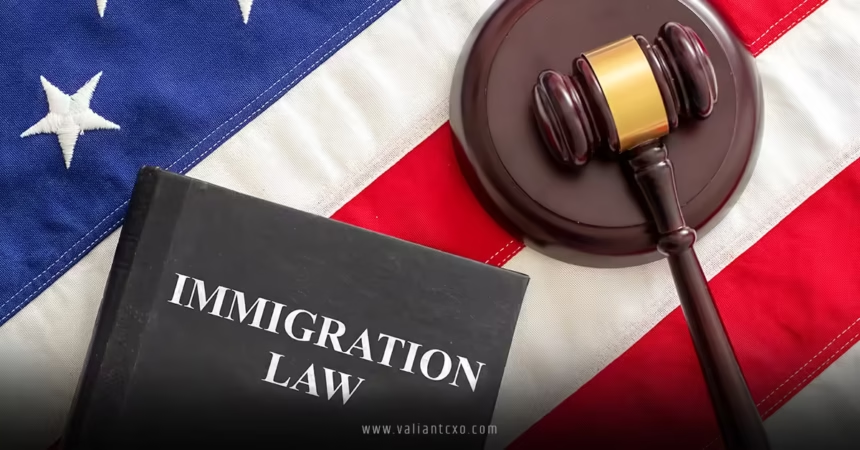U.S. Immigration Laws: Key Changes in 2025 have reshaped the landscape for millions of immigrants, employers, and families navigating the complex world of visas, green cards, and citizenship. If you’re scratching your head wondering what’s new, don’t worry—you’re not alone. The U.S. immigration system is like a giant puzzle, and 2025 dropped some big, shiny new pieces into the mix. From beefed-up border security to tweaks in visa programs, these changes are making waves. So, grab a coffee, and let’s dive into what’s happening, why it matters, and how it might affect you or someone you know.
Why U.S. Immigration Laws: Key Changes in 2025 Matter
Immigration laws don’t just sit in dusty books—they shape lives. Whether you’re an immigrant chasing the American Dream, an employer hiring global talent, or a citizen curious about the nation’s direction, U.S. Immigration Laws: Key Changes in 2025 touch everyone. These updates reflect a push for stricter enforcement, economic priorities, and national security, but they also spark heated debates. Are these changes making the system fairer or tougher? Let’s unpack the big shifts to find out.
A New Era of Enforcement
The U.S. immigration system in 2025 is leaning hard into enforcement. Think of it like a bouncer at a club, checking IDs with a flashlight and a no-nonsense attitude. One of the biggest moves is the “One Big Beautiful Bill Act” (OBBBA), signed into law on July 4, 2025. This isn’t just a catchy name—it’s a game-changer. The OBBBA pumps $45 billion into immigration detention facilities through 2029, expanding capacity to hold more people. It’s like building a bigger net to catch more fish, but in this case, the focus is on detaining undocumented immigrants, especially those accused of crimes.
The Laken Riley Act is another heavy hitter. It mandates detention and deportation for undocumented individuals accused of crimes like theft or burglary. Imagine you’re playing a board game, and suddenly the rules say, “Go straight to jail, no passing go.” That’s the vibe here—swift action with little room for negotiation. This law aims to prioritize public safety but has communities on edge, wondering who might get caught in the crosshairs.
Border Security: Building the Wall Higher
U.S. Immigration Laws: Key Changes in 2025 put border security front and center, like a spotlight on a stage. Executive orders from January 2025 call for a physical wall along the southern border and more personnel to patrol it. It’s not just about bricks and mortar; it’s about sending a message: crossing illegally just got harder. The administration is marshaling resources to achieve “complete operational control,” which sounds like something out of a sci-fi movie but means tighter grip on who enters the country.
These orders also pause asylum applications at the border, forcing people to apply from within the U.S. instead. Picture a door that’s slammed shut at the border but left slightly ajar elsewhere—it’s a shift that’s both restrictive and strategic. For those fleeing danger, this change feels like a detour on an already tough journey.
Visa Programs: A Mixed Bag of Opportunities
If borders are the front door, visas are the keys to the house. U.S. Immigration Laws: Key Changes in 2025 bring both opportunities and hurdles for visa seekers. Let’s break it down.
H-1B and H-2B Visas: Boosting the Workforce
The H-1B visa, a golden ticket for skilled workers, got a makeover in 2025. It’s now more “beneficiary-centric,” meaning it’s easier for workers to navigate the process. Think of it like upgrading from a clunky flip phone to a sleek smartphone—same purpose, better experience. Employers also face stricter “Ability to Pay” rules, ensuring they actually pay what they promise. This is great for workers but adds pressure on companies to keep their books in order.
The H-2B visa program, for temporary non-agricultural workers, got a temporary boost too. A rule from December 2024 added 64,716 extra visas for 2025, helping businesses facing labor shortages. It’s like throwing a lifeline to industries like hospitality or construction, but there’s a catch—most of these visas are for returning workers, so newbies might still be left out in the cold.
DACA and Dreamers: A Ray of Hope
For DACA recipients—those brought to the U.S. as kids—the news is bittersweet. U.S. Immigration Laws: Key Changes in 2025 include the Dignity Act of 2025, introduced by Rep. Maria Elvira Salazar. This bipartisan bill offers a path to legal status for undocumented immigrants who meet strict requirements, like passing background checks and paying back taxes. For Dreamers, it’s a chance to trade their temporary status for a green card if they’ve got a college degree, military service, or steady work history. It’s like finally getting a permanent seat at the table after years of standing in line.
But there’s a flip side. The Trump administration axed ACA Marketplace coverage for DACA recipients, leaving many without affordable health insurance. It’s a reminder that progress often comes with setbacks, like climbing a hill only to slip a few steps back.
Asylum and Humanitarian Programs: A Tighter Squeeze
Asylum seekers and those under Temporary Protected Status (TPS) are feeling the squeeze in 2025. U.S. Immigration Laws: Key Changes in 2025 make it harder to seek refuge, like narrowing a highway to a single lane.
Asylum Restrictions
New rules mean asylum applications can’t be filed at the border anymore. If you’re seeking safety, you’ve got to be in the U.S. already and file within a year of arrival. It’s like telling someone they can only call for help once they’re inside the house. Pending asylum cases are still active, and work permits can be renewed, but the process feels more like a marathon than a sprint.
TPS and Parole Programs: Winding Down
TPS for countries like Honduras, Nicaragua, and Cameroon ended or got shortened in 2025, leaving many scrambling for options. The CHNV parole program for Cuba, Haiti, Nicaragua, and Venezuela also wraps up in April 2025. It’s like the clock ticking down on a game show—time’s running out to find a new path. If you’re affected, talking to an immigration lawyer ASAP is your best bet to avoid being left in limbo.
Registration and Vetting: Eyes Everywhere
U.S. Immigration Laws: Key Changes in 2025 ramp up scrutiny like never before. Executive Order 14159, issued in January, requires all aliens over 14 to register with the government, including fingerprinting. It’s like signing in at a high-security event—everyone’s being watched. A new form, G-325R, makes it easier for undocumented immigrants to comply, but failing to register could mean criminal penalties. The vibe? Big Brother is taking notes.
Vetting is also tougher. The administration is reviewing all 55 million U.S. visa holders, checking everything from social media to phone data. It’s like having your entire digital life under a microscope. Even “good moral character” for naturalization now includes community service or caregiving, but minor slip-ups could tip the scales against you.
Economic and Social Impacts: Ripple Effects
U.S. Immigration Laws: Key Changes in 2025 aren’t just about rules—they’re about people and the economy. Immigrants make up 15.4% of the U.S. population and 19% of the workforce, fueling industries like tech, agriculture, and healthcare. But with deportations up and arrivals down, the foreign-born population dropped by over a million by June 2025. It’s like pulling a thread from a sweater—everything starts to unravel.
Workforce and Economy
Stricter laws could shrink the labor pool, hitting industries hard. Imagine a restaurant with fewer cooks or a farm with no pickers—things grind to a halt. On the flip side, the Dignity Act’s American Workers Fund aims to retrain U.S. citizens, balancing the scales. But will it be enough to fill the gaps?
Community Tensions
Tighter enforcement and ICE presence in schools or workplaces have communities on edge. It’s like living with a storm cloud overhead, never knowing when it’ll pour. Sanctuary laws in places like California are under fire, and legal battles are brewing. The fear? Families split apart, dreams deferred.
Legal Challenges: The Courts Push Back
Not everyone’s on board with U.S. Immigration Laws: Key Changes in 2025. Federal courts have blocked some moves, like the attempt to end birthright citizenship, calling it unconstitutional. Cases like Casa Inc. v. Trump and Washington v. Trump are keeping the administration in check. It’s like a tug-of-war between the White House and the judiciary, with immigrants caught in the middle.
The Dignity Act, while promising, faces hurdles too. Its success depends on Congress playing nice, which, let’s be honest, isn’t always their strong suit. Will bipartisan support hold, or will politics derail progress?
Navigating U.S. Immigration Laws: Key Changes in 2025
So, what’s the game plan? If you’re an immigrant or helping someone navigate this maze, here’s the deal: stay informed, act fast, and get help. Immigration laws are like a river—constantly moving, sometimes calm, sometimes wild. Here’s how to stay afloat:
- Check Your Status: Use tools like USCIS’s Alien Registration Requirement Determination Tool to see if you need to register.
- File Early: Whether it’s asylum, a visa, or a green card, don’t wait. Delays can cost you.
- Get Legal Help: An immigration lawyer is your GPS in this chaos. They’ll spot detours you might miss.
- Stay Updated: Follow trusted sources like USCIS for the latest news.
Conclusion
U.S. Immigration Laws: Key Changes in 2025 are a mixed bag—tougher enforcement, new opportunities, and plenty of uncertainty. From the OBBBA’s detention push to the Dignity Act’s hope for Dreamers, these changes are reshaping lives. Whether you’re an immigrant, employer, or advocate, staying informed is your superpower. The system’s complex, but you’re not alone—legal help and community resources are out there. Keep your eyes open, your papers ready, and your dreams alive. What’s next? Only time will tell, but you’ve got the tools to face it head-on.
FAQs
1. What is the One Big Beautiful Bill Act in U.S. Immigration Laws: Key Changes in 2025?
The OBBBA, signed in July 2025, boosts funding for immigration detention and enforcement, limits public benefits for immigrants, and expands border security measures.
2. How do U.S. Immigration Laws: Key Changes in 2025 affect DACA recipients?
The Dignity Act offers a path to legal status for DACA recipients with degrees, military service, or work history, but ACA Marketplace coverage was eliminated, impacting healthcare access.
3. Can I still apply for asylum under U.S. Immigration Laws: Key Changes in 2025?
Yes, but only from within the U.S., not at the border. You have one year from entry to file Form I-589, and pending cases can still renew work permits.
4. What happens if I don’t register under the new Alien Registration Requirement?
Failing to register with Form G-325R, as required by U.S. Immigration Laws: Key Changes in 2025, could lead to criminal penalties for aliens over 14.
5. Where can I find reliable updates on U.S. Immigration Laws: Key Changes in 2025?
Check USAHello or the American Immigration Council for regular updates and resources to stay informed.
For More Updates !! : valiantcxo.com


